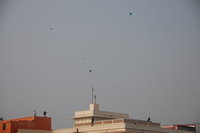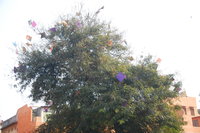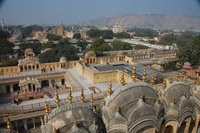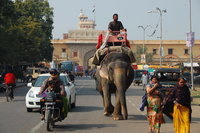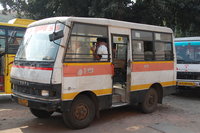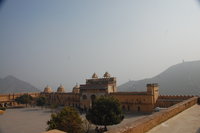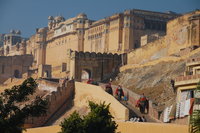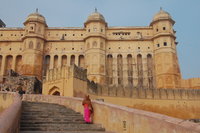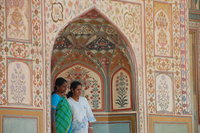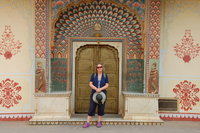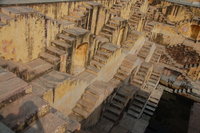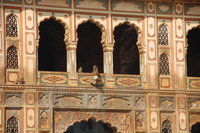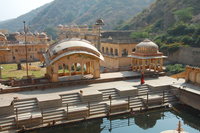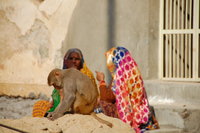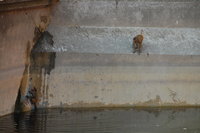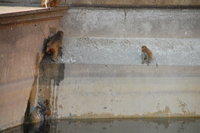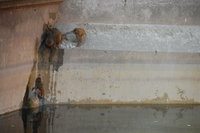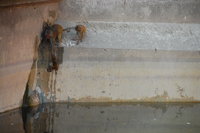To Jaipur aboard the Udaipur to Jaipur Express, 134km, two hours, zero camels. We were thrilled to learn that train number 12991 is classed as "super-fast". This means that its average speed is greater than 55km/h (34mph). As a result, it attracts a price supplement which explains why our tickets cost £0.98...each!
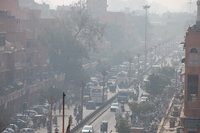
Jaipur is the capital of Rajasthan and is a relatively recent development by India standards. It has refreshingly wide streets and some "green" spaces (not often actually green, but the sentiment is there). The city's motto is "Clean Jaipur, Green Jaipur", but it seems more of an aspiration really. The government is insisting that the place is very clean and organised and that this is appreciated by the ever increasing number of tourists. In fact, they describe the city as "a poem in aesthetics", whatever that means. It is true that there is a conspicuous lack of cows here and this does mean one less thing to avoid stepping in, but the place could scarcely be described as clean and everything we have seen and heard indicates dramatically reduced foreign tourist figures. About 3.3M people live in this city (2014) and a significant number of them seem to sleep on the streets and in the parks. This is probably to be expected of a large administrative centre, but can make the place look rather unappealing. The city forms one corner of the so-called Golden Triangle (Delhi and Agra being the others). As a result, despite fewer foreigners overall, quite a number of westerners are to be seen on the streets. Those on whistle-stop tours of Rajasthan who don't have the time to acclimatise don't always seem to be enjoying the experience!
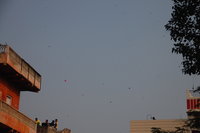
The Jaipur district is currently in the grip of a Swine Flue epidemic. We did not time our visit here specifically to coincide with this, but we did make efforts to ensure we were here for the kite festival. Concerned about the Swine Flue, we were somewhat reassured to read in the Indian Times that the Jaipur hospitals were making additional preparations in expectation of an influx of patients...Reassured, that is, until we read that these preparations were in anticipation of "kite string injuries"!
Our first day here was a public holiday and also the aforementioned kite festival, so we took to those wide streets to wander around taking advantage of the decreased amount of traffic and the increased chance of survival. Whilst we did not see the international kite experts doing their thing, the sky was full of the small paper and bamboo kites favoured by the children (and adults, it seems). We discovered that many of the kites use a metal coated string, since the object of the exercise is to cut down other kites mid-flight. The government is trying to put a stop to this since it injures birds as well as people. Regardless of this, the skyline was full of people on roofs trying frantically to bring down their opponents. It was all very good natured and we were invited to participate a number of times. Steve proved himself particularly inept at kite-combat, much to the amusement of the locals.
The day after the holiday, we read in the paper that the hospitals' concerns and preparations were well founded since quite a number of people had been admitted with kite-related injuries. These were either children running out into the road chasing errant kites, slices from the cheese-wire string or people falling off building roofs.
We discovered an additional hazard in that the entire city is covered in kite string. Before crossing the road, it is essential to check you are not bound by a long piece of metal wire to a lamppost. Walking around here is like diving on a heavily fished wreck, the entanglement risk is ever present. Often we have had to stop and untangle each other whilst simply walking down the street. At other times, one of us would stop abruptly having spotted some metal string stretched across the road at eye level!
In other health-related matters, during our stringy wanderings, we managed to find ourselves outside the Sawai Man Singh Hospital...which is where they are bringing all the Swine Flue victims. We disentangled ourselves from the lamppost and hurried on.
Despite the streets being wide they are, of course, still jam-packed with hooting cars, buses, motorcycles and auto-rickshaws and have no usable pavements. Our daily walk into town involved trudging along a main road reassuringly labelled on our map as the M1. It is a large dual-carriageway lined on both sides with shops, stalls and parked motorcycles. Often we have to walk down the middle to make any progress since the pavements are for sleeping, urinating and riding motorcycles. Crossing this road is probably best not even discussed! Corporate sponsorship and advertising is as ubiquitous here as anywhere else, with Nokia and Samsung being particularly prevalent. The problem is, when you take a look in any of these shops, you find off-cuts of old cloth, hand-powered sewing machines or things made from sugar and flies! There is a MacDonald's on the M1, but it does not sell beef products (of course) and there is a shop selling Levi,s [sic]. Mainly, however, it is yards and yards of colourful sari material or strange pointy shoes. Shopping, though, is rather fun. As we walk along deafened by the mêlée of Hindi shouting, horns and internal combustion engines, voices emerge from the shops in English..."welcome to my shop"..."looking is free"..."quality trousers only 500 roupees". If you dare to stop and ask the price of anything, they won't tell you unless you remove your shoes, enter the shop and sit down. Then the bait and switch begins. As ever though, it is very good natured. Megan now has trousers with camels on them, but she did barter the guy down to £2.00, so fair play.
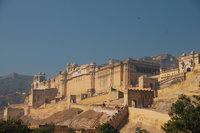
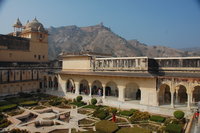
Prior to the development of the current city of Jaipur, the main town was at Amer about 11km up the road and this is the location of the old palace. Amer is also known as Amber and the palace is often referred to as the Amber Palace, which is a convenient happenstance since it actually is yellow - as is the entire old town. The place is extremely popular with gringo tourists and one highlight of a trip around the Golden Triangle is a ride on an elephant up the approach road to the palace.
First though, we had to actually get to Amer. We learned that it was possible to hire a driver who would take us the 15km from our hotel to Amer, wait around for five hours and then bring us back; all for a mere £11.00, which seemed rather convenient. So, we took the local bus instead, which cost £0.20...each way! The Tata-bus was dirty, uncomfortable and rammed with people but again, all very good natured, As the driver leaned on the horn and lurched randomly around the streets, we were all thrown around against one another. Everybody seemed to be laughing so we laughed too, as though this was a sensible and reasonable way to travel.
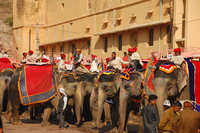
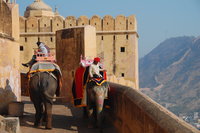
Upon arrival at Amer and being qualified mahouts (elephant drivers), we thought we should give the elephants a go to see how good the local drivers are. It's not quite the same as what we did in Thailand as this time we had to sit on a seat on the back rather than in the mahout's position just behind the ears. This seat is, of course, the position the Maharaja would have had and it was rather splendid plodding up the approach road (which was clearly purpose built for these animals) before turning through the large gate into the main courtyard. Megan had insisted on visiting the market before we left to purchase some bananas so our elephant got a bit of a treat at the end. In our opinion, the mahouts do seem to know how to handle their beast (unlike the bus drivers) and, as a bonus, there is no horn on an elephant.
The Amer Palace is one of the most impressive we have seen to date. It has a spectacular location above its own private lake and gardens and below the Amer Fort. The entire old city and the palace are surrounded by fortified walls and turrets. With the walls clinging to the mountain-tops and looming out of the early morning mist, we were both reminded of the Great Wall in China...only yellow.
After visiting the Amer Palace, Megan also visited the Anokhi Museum. According to Megan, Anokhi imports Indian goods into the UK or something. It must have been good a good muesum as Steve had to sit in the café outside for what seemed like hours (and actually was). It's something to do with block printing. On the way there, we stopped to take a quick look at a step well the like of which we had not seen before. This well looked like an M.C.Escher painting with steps descending to the water at seemingly impossible angles.
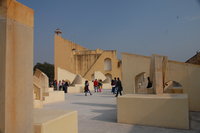
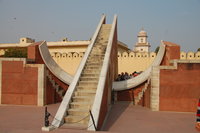
Some dude called Sawai Jai Singh scrapped Amer Palace (and the entire town) in the 18th century and started to build a new city down the road. In truly modest style, he named it after himself and, to avoid confusion, made it pink rather than yellow. Today, Jaipur is often known as the Pink City. Mr Jai Singh was fascinated by all things astronomical (and astrological) and he built a place called the Jantar Mantar in down-town Jaipur (Jantar means instrument, Mantar means calculation). He built five such observatories around the country (there is one in Delhi). This one houses one of the world's largest sundials (27m), which the guides will breathlessly inform you can indicate the time with an accuracy of 2s. Actually, engineering incompetence and subsidence mean that this is not really true. Never the less, the garden with some 18 instruments constructed of stone and marble was a fascinating place to wander around. Plus, if it ever happened to be cloudy, there is a convenient clock-tower visible just over the wall - cunning.
Discovery Channel made a program about how animals adapt to life in close proximity to humans. It showed monkeys jumping into man-made pools of water to cool off. The location where this was filmed is on the outskirts of Jaipur, so we decided to make a trip to see the Galta Temple (imaginatively known these days as the Monkey Temple).
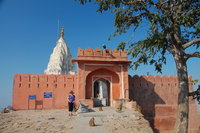
To get to the Galta Temple, we had to walk up into the hills to the east of Jaipur. This involved navigating a filthy track populated with cows, goats, pigs, sheep, monkeys and youths. At the top of this track is the Sun Temple. This is the only temple we have visited where you don't have to take your shoes off until you are inside. It is left as an exercise for the reader to decide which of the above would make off with your footwear if you left it outside.
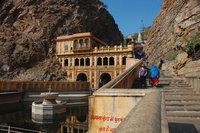
After Megan had had the obligatory dot applied to her forehead and we had made the requisite donation, we left the Sun Temple and descended into a valley where we found the Galta temple. As usual, it is in a parlous state of repair and is covered in all manner of unidentifiable substances. What is left of the architecture is splendid and the location is great. The monkeys are a bit of an aggressive nuisance, but no more so than the "guides" who badger you for money.
At the entrance to the temple complex a monk showed us the 800 year old monkey temple. Later on, down in the main complex, a monk showed us the 800 year old monkey temple...
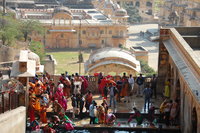
The world-famous pools are the so-called tanks or sagars that form part of the design of many temples and also are sacred bathing places for pilgrims and locals alike. It appears that the presence of so much water attracts the monkeys who amuse themselves jumping from the temple into the water. Being bright, the monkeys only do this in summer when the water is warm and they are really hot. Being not so bright, we came to see this spectacle in the middle of winter. We did see a few fall in and a rescue operation had to be mounted for one of them (see below).
Actually, it may be that the monkeys didn't fancy a dip in the water as it was filthy, disgusting and full of rubbish (like virtually all pools of water we have seen on this trip). This did not deter the pilgrims though or those who had just come to wash! Megan enumerated all sorts of diseases that would be present.
Our hotel in Jaipur was a little away from the centre, but conveniently located near a rather splendid café that specialised in all manner of chocolate edibles. It was also located right next to a building site with an industrial hammer-drill boring into solid rock all day every day (including Sunday); thus saving the hotel owners the trouble of having to employ a man who hammers. As a result, they splashed out extra on people who make dust. The hotel had a nice roof-top restaurant that provided a great view of the building site and which also had very good and reasonably priced food...until they decided to increase the prices by 50% half way through our stay. On our last day, there was a brief respite in the mechanised hammering and we realised that the hotel did indeed employ a man who hammers, he just wasn't up to the competition.
The hotel helpfully provided us with a brochure telling us what we could see and do in Jaipur. Its publication date was Jan 2015 and, in addition to supplying pricing information from about 10 years ago, it included some helpful advice for the traveller including:
...and the extremely helpful...
Good advice in anyone's book.
In other news, the country is in a frenzy over Obama's visit next week (along with his 1600-strong security detail) and Steve has contracted some kind of cold...time will tell which of these events is the most significant.
Next time, all being well, we will continue our journey eastwards. The plan is to finally leave Rajasthan and take the train to Orchha in the state of Madhya Pradesh. There is some question as to how well this will go since, on a good day, the train takes over 8 hours. According to the Indian Railways website, there are very few good days for this train! We enjoyed our time in Jaipur, but are hankering after the small town and the cow once more. See you there!
